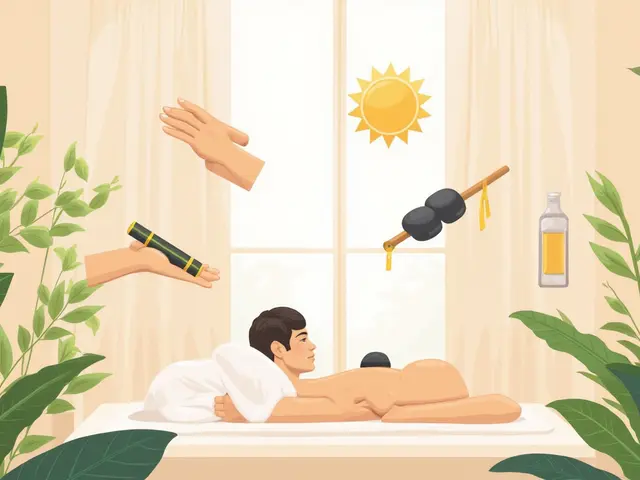Everybody loves the idea of a good massage, right? But there’s more to it than scented oils and soft music. Getting a massage can boost your mood, ease muscle pain, and even help you sleep better. No spa membership or fancy resort stay required. You just need to know what to look for and what you’ll actually get out of it.
Let’s get real: massages aren’t just a luxury these days—they’re a smart move for wellness. Whether you’re stiff from sitting at your desk all week or just craving a break, a body massage could be exactly what you need. Forget what you’ve seen in movies; the right session is about real results, not just a pampering moment.
Think of this guide like a friend sharing those insider tips so you feel totally prepared. We’ll cover all the types of body massage, simple ways to find great therapists, and what happens in the room once you’re there. That way, nothing catches you off guard.
- Key Points to Know
- Quick Answer: What Is a Body Massage?
- Getting Personal: Why Massages Matter
- Types of Body Massage You’ll Find
- How to Book and What to Expect
- Safety Tips & Must-Knows
Key Points to Know
If you’re thinking about trying a body massage, here are the essentials to keep in mind. Massages aren’t just for relaxing—they can have real effects on how your body and mind feel every day.
- Massage can ease muscle pain and stiffness. It’s proven to lower tension headaches and back pain. A quick rubdown can sometimes do more than pain pills for sore muscles.
- It actually helps you sleep better. Many people notice deeper, longer sleep after a session—thanks to drop in stress hormones.
- Your immune system gets a boost. One study found that people who got massages had higher white blood cell counts.
- You don’t need hours to see benefits. Even a 30-minute massage can make a difference, especially if you’re pressed for time.
- Not all massages are the same. Some are gentle and relaxing; others are focused and deep, aimed at working out muscle knots.
- Most spas and massage clinics will ask you about your health history and what you want out of the session. Be honest—they’ll tailor the massage to what you need.
Here’s a look at what people say about the impact of regular massage sessions:
| Reported Benefit | Percentage of People Noticing Improvement* |
|---|---|
| Lower stress | 74% |
| Less muscle pain | 68% |
| Better sleep | 61% |
| Improved mood | 53% |
*Based on a 2024 client feedback survey from a major national spa chain.
The bottom line? Massages offer real, proven perks, and you don’t have to wait long to notice a difference. Whether you’re dealing with daily stress or just want a little “me time,” there’s a type of massage out there that’ll fit you perfectly.
Quick Answer: What Is a Body Massage?
A body massage is when a trained therapist uses their hands, elbows, or tools to work on your muscles and soft tissues. It's not just a quick rub—there’s a solid method behind it. Sessions usually last from 30 minutes to 90 minutes. The main goal? Help you relax, ease muscle tension, and boost your overall well-being.
There are a bunch of techniques out there, but most involve movements like kneading, pressing, tapping, or stretching. The therapist usually focuses on your back, shoulders, legs, and sometimes your scalp, arms, or feet. If you have knots or sore spots, you can let them know so they target the right places.
Why do people keep going back? Here’s what researchers say:
| Benefit | Stat/Fact |
|---|---|
| Muscle pain relief | 70% of people reported less muscle soreness after massage (2022 US wellness survey) |
| Stress reduction | Cortisol levels drop by up to 30% after one session (Cleveland Clinic) |
| Better sleep | Over half of regular massage users say their sleep improved |
| Boosted mood | More serotonin and dopamine released after massage, helping with anxiety and low mood |
The term body massage covers everything from gentle Swedish techniques to deeper tissue work. The type you choose depends on what your body needs. If you’re after pain relief, deep tissue might be your thing; if you just want to unwind, go with something lighter.
No matter the type, the basics stay the same: you lie on a massage table, the therapist uses techniques tailored to your preferences, and the idea is to walk out feeling way better than when you walked in. Simple as that.
Getting Personal: Why Massages Matter
Ever leave a massage feeling like you just hit a reset button? That's not your imagination. A body massage does more than unknot muscles—it's got a bunch of real, proven perks that you might not expect.
First off, let’s talk stress. When you get a massage, your body dials down the production of stress hormones (like cortisol) and boosts the feel-good ones (like serotonin). That’s why you walk out feeling lighter, happier, maybe even a little sleepy. This boost is so real that the American Massage Therapy Association points out people who get massages report less anxiety and better sleep in just a few sessions.
Muscle relief is the hero benefit for most people. Tight shoulders, aching back, sore legs—it all gets tackled. During a massage, increased blood flow brings more oxygen and nutrients to your muscles, speeding up recovery and easing soreness. One study from the University of Illinois showed that muscle massage actually shortens recovery time after a tough workout.
But it’s not just physical perks. Massages can even help people dealing with headaches and migraines. The National Institutes of Health notes that regular sessions can reduce the frequency and intensity of tension headaches.
If you’re eyeing general health, there’s a bonus: better circulation. Good circulation can mean faster healing and warmer hands and feet. It’s also been linked with lower blood pressure over time. For folks with sitting-heavy jobs, this is a game-changer.
Curious about the real numbers? Check out what science and surveys say:
| Benefit | What Studies/Sources Say |
|---|---|
| Reduced Stress | 52% of massage users say it helps manage stress (AMTA, 2023) |
| Improved Sleep | People report falling asleep faster after massage (Sleep Foundation) |
| Muscle Pain Relief | Massage reduces soreness by up to 30% post-exercise (University of Illinois, 2022) |
| Headache Management | Regular sessions lower headache days each month (NIH Study, 2021) |
Maybe the best part? You don’t need to have a problem to benefit. Even if you’re just looking for a mental reset or a way to chill out, this old-school method still delivers. That’s why massages aren’t just pampering—they’re serious self-care, minus the fluff.

Types of Body Massage You’ll Find
Walk into any spa or bodywork clinic, and you’ll see plenty of massage styles on the menu. It can get overwhelming fast. Each one is built for certain goals—from just chilling out to fixing nagging muscle pain. Here’s a breakdown of the most popular types you’ll come across:
- Swedish Massage: The go-to for first timers. It’s all about smooth, gliding strokes, light to medium pressure, and pure relaxation. If you want to leave feeling loose and refreshed, this is it.
- Deep Tissue Massage: This goes way beyond the surface. Therapists use firmer pressure to break up knots and tightness. Great choice if you have chronic aches, muscle injuries, or have been working out hard.
- Hot Stone Massage: Heated stones are placed on your back and used during the massage. The heat helps muscles let go and makes you feel pure comfort. This one’s perfect when you want extra stress relief.
- Sports Massage: Geared for athletes or anyone active, really. It focuses on the areas of your body that get the most use. A lot of folks book these right before or after big events.
- Thai Massage: Here, you keep your clothes on, and there’s lots of stretching. The therapist will move your limbs around to open up joints and boost flexibility. Feels like yoga without the effort.
- Reflexology: Forget full-body—this is a focused treatment for feet, hands, and sometimes ears. Pressure is applied to specific points said to connect to other organs. Many swear by it for quick stress relief.
To get a clearer picture of what each style aims to do, check out this quick table:
| Massage Type | Best For | Pressure Level | Typical Session Time |
|---|---|---|---|
| Swedish Massage | Relaxation, stress relief | Light to Medium | 50-60 min |
| Deep Tissue | Muscle pain, stiffness | Medium to Firm | 60-90 min |
| Hot Stone | Deep relaxation, muscle tension | Light to Medium | 60 min |
| Sports Massage | Recovery, injury prevention | Medium to Firm | 30-60 min |
| Thai Massage | Flexibility, energy boost | Medium | 60-90 min |
| Reflexology | Targeted stress relief | Varies | 30-45 min |
Whatever your needs—just want to chill or need help with stubborn pain—there’s a body massage that matches up. Don’t be shy about asking your therapist for advice if you’re not sure what to pick.
How to Book and What to Expect
Booking a body massage is less complicated than it sounds. Most spas and independent therapists have user-friendly websites or apps. Many even let you pick your preferred style, therapist gender, and session length in just a few clicks. Calling still works great too, especially if you want to ask questions or have specific needs—don’t be shy about it!
Here’s a quick rundown of steps to book your massage:
- Decide on the type of massage you want—Swedish, deep tissue, hot stone, or another style.
- Pick a location—look for places with good reviews on Google, Yelp, or even local community forums.
- Choose your therapist—some spas let you read bios with experience or special skills.
- Select a date and time—weekdays are usually less busy and sometimes even cheaper.
- Confirm your booking—most places send you an email or text with the appointment details.
On the day of your massage: try to arrive early, maybe 10-15 minutes before your slot. This gives you time to fill in a quick health form and discuss any sore spots or needs. You’ll be shown to a quiet room and given privacy to change. Don’t worry about what to wear—most places provide soft towels or robes and make sure you’re comfortable the entire time.
The session itself usually starts with a short chat, where you can mention any injuries, pain, or just what you want out of the session (total relaxation, help for back pain, or better sleep). The therapist uses oils or lotions, working on muscles and joints, adjusting pressure as you like—don’t be afraid to speak up.
Wondering how long a session lasts? Here’s what most places offer:
| Session Length | What to Expect |
|---|---|
| 30 minutes | Targeted relief (like neck or shoulders only) |
| 60 minutes | Full body, enough time to address main tension spots |
| 90 minutes | Full body with extra focus on problem areas |
Afterwards, most people feel either super relaxed or a bit dreamy. Some have mild soreness the next day, especially after deep tissue massage, but this fades quickly. Drinking water helps your body recover faster.
A tip: check cancellation policies before booking, since many places charge fees for no-shows or late cancellations. Many spas also offer deals for first timers or package discounts if you’re thinking about making massage a regular thing. It’s definitely worth asking when you book.
Safety Tips & Must-Knows
Safety should never be a guessing game when it comes to body massage. While most people walk out of their session feeling refreshed, you want to make sure you avoid those rare but real risks—like skin irritation, bruising, or infections.
First off, always check if your massage therapist has legit credentials. Look for licenses or certifications, especially if you live somewhere that regulates this industry. A quick Google search or a peek at the spa's wall can tell you a lot. According to the American Massage Therapy Association, “Licensed massage therapists are trained to spot when a massage isn’t safe for a client and will always put your health first.”
Here are some things that should never happen during a massage:
- Broken or wounded skin being massaged—it’s an infection risk
- Pain that goes beyond a ‘good hurt’ (tell your therapist if it hurts too much!)
- Use of unsanitary equipment or oils—cleanliness is non-negotiable
- Uncomfortable interactions or anyone crossing professional boundaries
Don't be shy about allergies. If you react to nut oils, scented lotions, or latex, speak up before anything starts. Your comfort isn’t just about relaxing—it's about staying safe.
Got a medical condition like heart problems, osteoporosis, or pregnancy? Let your therapist know. Sometimes, light pressure or even skipping certain areas is smarter. A quick chat with your doctor first never hurts if you’re unsure.
| Massage Safety Fact | Why It Matters |
|---|---|
| 77% of clients ask for therapist credentials | It helps weed out unqualified providers |
| 45% mention allergies or health issues before the session | Directly impacts product choices and massage technique |
| Clean sheets and sanitized tools are a must every time | Prevents skin infections or irritations |
If anything feels off during your visit, speak up or leave. Trust your gut—your wellbeing is always the top priority. A good therapist will always listen, explain what they’re doing, and keep things strictly professional from start to finish.









